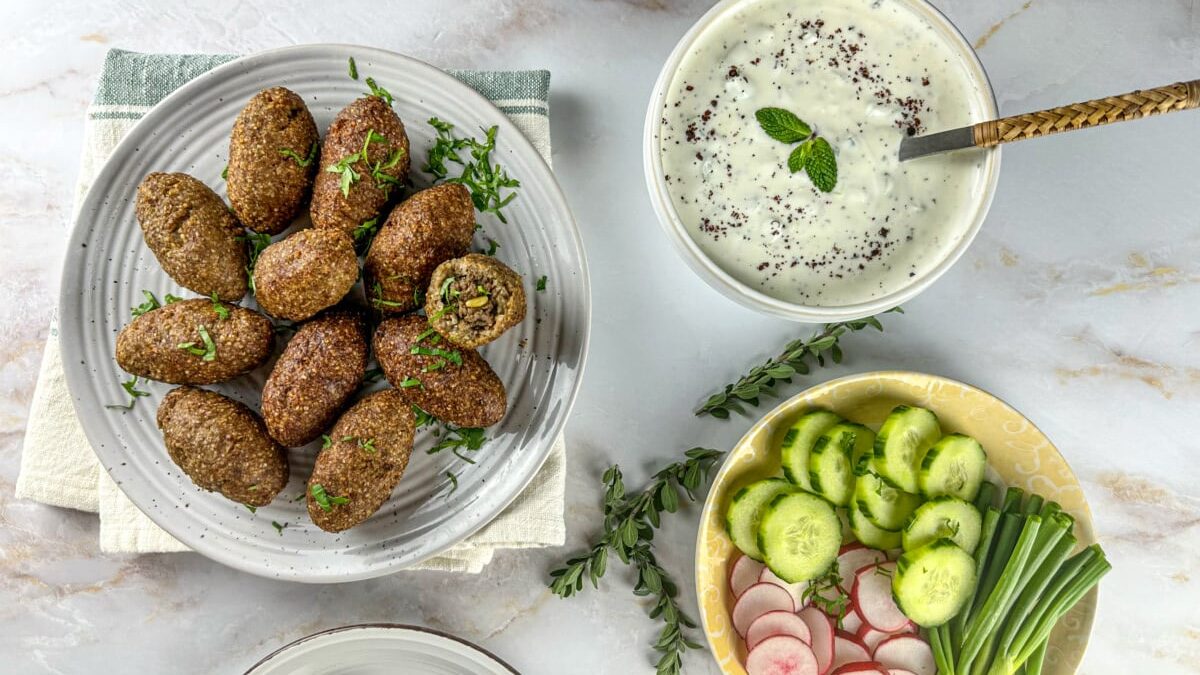Lebanese Kibbeh Recipe: A Classic Middle Eastern Appetizer
Kibbeh: A labor of love, a burst of flavors, a Middle Eastern delicacy that’s truly worth savoring. Dive into the world of exquisite tastes!
Table of Contents
Lebanese Kibbeh Recipe: Explore the culinary masterpiece of Kibbeh, beloved in Lebanon and the Middle East. Perfect for your mezze lineup! It’s a fantastic addition to creamy hummus and spicy muhammara with warm pita wedges or dipped in tangy moutabal and crunchy tabbouleh.
I still remember watching my mom craft these delightful delights with perfect precision. She’d lovingly combine bulgur and meat, season them to perfection, and then shape them into round shells for stuffing. They were always laced with onions and pine nuts, of course! Kibbeh truly takes an expert hand in preparing correctly. So, when someone serves up one of these bites, you know they’ve cooked from the heart.
After much trepidation and uncertainty, I’ve taken the plunge with confidence that this recipe will delight you! If you’re new to kibbeh-making, read on for tips that can quickly turn you from a kitchen novice into a Kibbeh connoisseur. You might even surprise yourself by sharing mouthwatering photos of your culinary masterpiece!
Key Ingredients for Lebanese Kibbeh Recipe
- Bulgur: The choice of #1 bulgur is crucial for achieving Kibbeh’s smooth and desirable texture. It’s essential to wash and drain the bulgur thoroughly, but avoid soaking it, as it needs to maintain some firmness. Patting it dry ensures the right consistency in the shell.
- Herbs: The combination of dry mint and fresh or dry marjoram infuses Kibbeh with its distinctive Middle Eastern flavors. These herbs add aromatic complexity and contribute to the overall taste profile.
- Ground Beef: Lean ground beef forms the heart of the Kibbeh shell, providing the necessary meaty richness and texture. It’s essential to choose lean beef for a balanced result.
- Spices: The blend of salt, cinnamon, and black pepper adds layers of flavor to the Kibbeh shell, enhancing its taste and aroma.
- Ice-Cold Water: Adding ice-cold water in the right proportion is crucial to achieve the proper consistency of the Kibbeh shell. It helps bind the ingredients and create the desired texture.
- Regarding the stuffing, ingredients like ghee, olive oil, ground lamb or beef, spices, lemon juice, and, most notably, pomegranate molasses play significant roles in imparting rich, savory, and tangy flavors. The pomegranate molasses adds a unique and essential depth to the stuffing, enhancing the overall taste profile of the dish. Additionally, toasted pine nuts contribute a delightful crunch and nutty flavor, completing the stuffing’s delicious composition.
Tips and Notes for Perfecting Kibbeh Recipe
If you’re new to cooking Kibbeh, these tips will help you create an authentic and delicious dish:
- Bulgur Basics: Use #1 bulgur for the best results. Remember not to soak it; wash it thoroughly to remove impurities, then pat it dry with a paper towel. This ensures a smooth, crispy shell with a perfectly cooked interior.
- Lean Meat Choice: Opt for at least 90% lean ground beef when making the shell for a balanced texture and flavor.
- Shaping Skill: Shaping Kibbeh may take some practice, so be patient; it’s a skill that improves over time.
- Freezing for Convenience: Consider freezing Kibbeh before frying. Lay them flat on parchment paper inside a Ziplock bag and place them in the freezer for easy access.
- Frying Expertise: Frying Kibbeh can be a bit tricky. Ensure the oil is hot enough and there’s enough of it to cover the Kibbeh. Avoid overcrowding the pan; let them sit for about 30 seconds before flipping.
- Balanced Spices: Use spices in moderation to enhance the dish without overpowering it. Marjoram, fresh or dry, is a popular choice, but fresh basil works well too. You can also experiment with spices like cumin and mace for added flavor.
With these tips, you’ll be on your way to mastering the art of crafting perfect Kibbeh.
Varieties of Lebanese Kibbeh
Lebanese Kibbeh is a beloved Middle Eastern dish cherished by enthusiasts worldwide. Its versatility allows it to be served in various ways, making it suitable as a main course, appetizer, or snack, often accompanied by various sides and dipping sauces. Here are some common variations:
- Fried Kibbeh: This classic variation involves deep-frying balls or patties made from ground meat and bulgur wheat. The result is a crispy delight that’s widely enjoyed.
- Raw Kibbeh (Kibbeh Nayeh): A delicacy among Kibbeh enthusiasts, this variation is made from finely ground beef or lamb combined with bulgur, onions, and a blend of spices. It’s often served with fresh herbs and a drizzle of olive oil, showcasing its rich flavors.
- Baked Kibbeh: On the other hand, it offers a healthier twist. It is created by layering the Kibbeh mixture in a baking dish and then baking it until it becomes crispy and golden brown. It pairs wonderfully with yogurt or tahini sauce.
- Other Variations: Lebanese Kibbeh offers a world of culinary exploration. You can discover grilled, stuffed, or boiled versions with unique flavor and texture. These variations open up a world of diverse possibilities for savoring this beloved Middle Eastern dish.
What is Bulgur, and Where can you Find it?
Bulgur is a crucial ingredient in kibbeh recipes, and the quality of bulgur you use can significantly impact the final result. It’s a whole, unrefined grain commonly used in Lebanese cooking.
You can typically find bulgur in well-stocked grocery stores, often located near other grains like dry beans, rice, and barley pearls. With the growing popularity of diverse cooking ingredients, many stores now carry bulgur.
If you’re looking for a wider selection or prefer to shop at Middle Eastern stores, they will likely have bulgur readily available. Additionally, you can easily order bulgur online if it’s not readily accessible in your local stores. Rest assured, you will likely find this essential ingredient for your kibbeh recipe.
Preparation





For the perfect kibbeh, divide the dough evenly by weighing each one to 4 oz a piece. You can also eyeball them and form them into a ball.
Keeping a cup of water to dip your fingers in while forming the kibbeh is essential. This will prevent the dough from sticking to your fingers.






Ingredients:
Adjust Servings
| 2 tablespoons ghee | |
| 2 tablespoons olive oil | |
| 2 cups chopped onion (one large onion or two small ones) | |
| 1 lb. ground lamb or beef | |
| 1 teaspoon salt | |
| ½ teaspoon black pepper | |
| ½ teaspoon seven-spice powder | |
| ¼ teaspoon cinnamon | |
| 2 tablespoons fresh lemon juice | |
| 2 tablespoon pomegranate molasses | |
| ¼ cup toasted pine nuts |
Making the Kibbeh Shell:
| 1 large onion (chopped roughly) | |
| 2 cups bulgur # 1 (washed and drained) | |
| 1 lb. lean ground beef | |
| 2 teaspoons salt | |
| 1 teaspoon dry mint | |
| 1 teaspoon fresh or dry marjoram | |
| ¼ teaspoon cinnamon | |
| ¼ teaspoon black pepper | |
| ½ cup ice cold water or as needed |
Preparation
Rana’s Notes!
Nutrition Information
The information shown is an estimate provided by an online nutrition calculator. It should should not be considered a substitute for a professional nutritionist's advice.
See our full nutrition disclosure here.







I would love to hear your experience!
Have you made this Lebanese Kibbeh? I love to hear your feedback. Feel free to leave me a comment below.